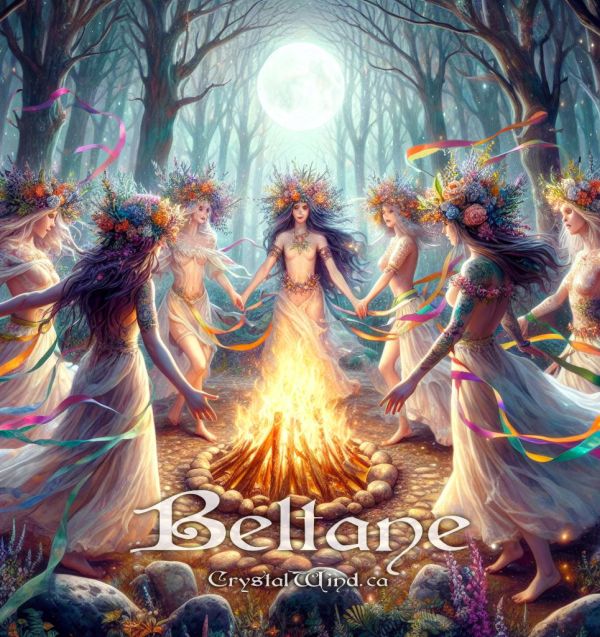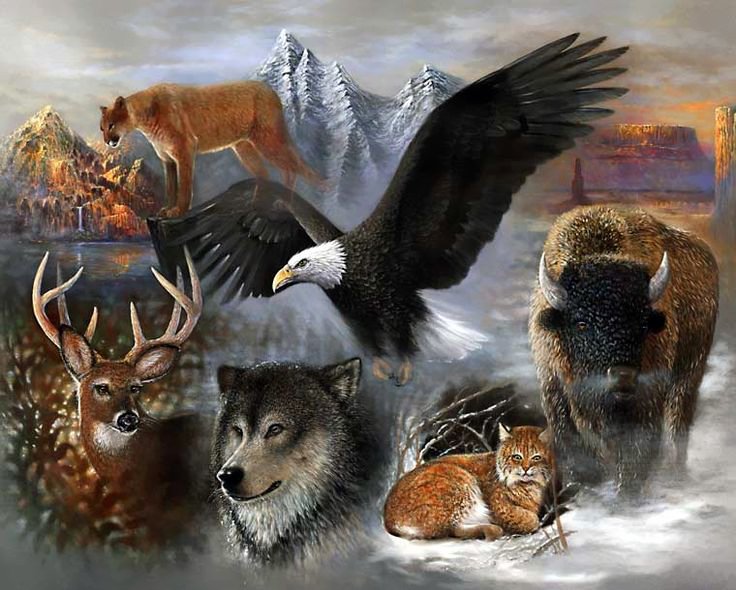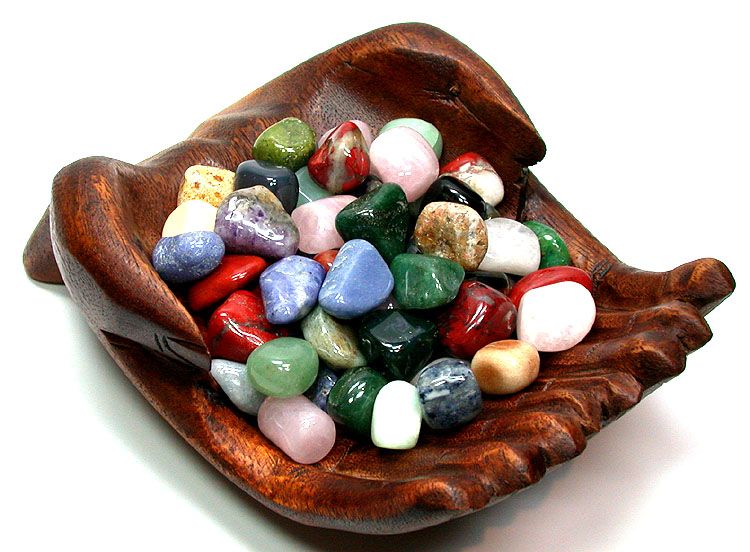Beltane
- Details
- Written by CrystalWind.ca
- Views: 10882

Beltane Ritual Celebrated May 1st
Beltane is also known as May Day, Walpurgisnacht, and Roodmas.
Beltane celebrated fertility and joyous revelry, with people of all ages engaging in passionate encounters in the Greenwood. For one night, married couples could set aside their wedding rings and their constraints. Women wove flowers into their hair, and both men and women adorned their bodies. Returning home, they stopped at each house to leave flowers and share in the finest food and drink. Villages erected a maypole, typically birch or ash, sparking dancing and feasting. Many chose a virgin "May Queen" to lead songs or processions.
To the Celts, she embodied the virgin goddess transitioning from Maiden to Mother. Her consort, known as "Jack-in-the-Green," "Green Man," "May Groom," or "May King," varied by region and era. Their union symbolized the world’s fertility and renewal, representing the Love Dance of the Gods, the Wedding of Heaven and Earth, and the Goddess’s Bridal Feast. Handfasting’s, trial marriages lasting a year and a day, were common, allowing couples to test their bond before committing to a lifelong union. Our ancestors recognized that true understanding comes from living together, and relationships endure only through mutual choice.
Maypole
Beltane celebrations prominently featured maypole dancing, symbolizing the union of the God and Goddess. The pole represents the God, while the enveloping ribbons embody the Goddess, displaying a rainbow of colors. Maypoles took various forms—pole, tree, bush, or cross—and could be communal or household, permanent or erected annually. In Germany, young unmarried men cut a fir tree on May Eve, stripped its branches, decorated it, and set it up in the village square, guarding it overnight until the May Day dance. In England, permanent maypoles stood on village greens, with some households having smaller ones in their yards. Ribbon dances involved two interweaving circles, while clockwise dances circled a decorated bush or tree.
May Waters
In May, the morning dew, streams, and springs hold a special magic, collected for bathing to enhance beauty or drinking to promote health. Traditional May Water rituals include rolling in dew on May Eve or washing the face in pre-dawn May Day dew for health, luck, and beauty; wetting the head and hair in Beltane rain for blessings; adorning springs, ponds, and sacred waters with flowers, garlands, and ribbons; and scrying in sacred springs, wells, and ponds.
Correspondences
Symbolism: The Union of the Goddess and the God, Fertility in all things. A time of making things fertile.
Symbols: Maypole, Mayday baskets, bonfires, flowers, ribbons, flower crowns, fairies.
Food: dairy foods, foods made with flowers, red fruits such as strawberries and cherries, green herbal salads, red or pink wine punch, maybowl (an icebowl decorated with spring flowers and filled with maywine), large round oatmeal or barley cakes (known as Beltane cakes or Bannocks), shellfish and other aphrodisiacs.
Herbs: Rose, elder, mugwort, mint, lily of the valley, foxglove, broom, hawthorne, almond, angelica, bluebells, daisy, marigold, frankincense, lilac, yellow cowslips, thyme.
Incense and oils: Rose, sandalwood, frankincense, lilac, mint.
Colors: Red, white, green, yellow.
Stones: Emerald, malachite, carnelian, amber, sapphire, rose quartz.
Animals: bee, goat, cat, lynx, horse, leopard, swallow, dove, swan.
Mythical creatures: Faeries, Pegasus, satyrs, giants.
Some appropriate Goddesses: all fertility, flower, song & dance, hunting, and virgin-mother Goddesses; Aphrodite (Greek), Artemis (Greek), Belili (Sumerian), Bloddeuwedd (Welsh), Cybele (Greek), Damara (English), Danu (Irish), Diana (Greek), Fand (Manx-Irish), Flidais (Irish), Flora (Roman), Frigg/Freya (Norse), Ishtar (Assyro-Babylonian), Rhea (Greek), Rhiannon (Welsh), Venus (Roman)
Some appropriate Gods: all fertility, love, hunting, and young father Gods; Baal (Phoenician), Bel (Sumerian), Cernunnos (Celtic), Cupid (Roman), Eros (Greek), Faunus (Roman), Frey (Norse), The Great Horned God (European), Herne (English), Orion (Greek), Pan (Greek)
Decorations: maypole, lots of flowers, flower wreaths, ribbons.
Activities: making Maybaskets, Maypole dancing, jumping bonfires, May Water activities as listed above, gathering flowers, enacting the Great Rite, blessing your garden by making love in it.
Spell/ritual work: youthful exuberance, sensuality, pleasure, crop blessings, creative endeavors.
A Celebration of May Day
'Perhaps it's just as well that you won't be here...to be offended by the sight of our May Day celebrations.'
--Lord Summerisle to Sgt. Howie from 'Thee Wicker Man'
There are four great festivals of the Pagan Celtic year and the modern Witch's calendar, as well. The two greatest of these are Halloween (the beginning of winter) and May Day (the beginning of summer). Being opposite each other on the wheel of the year, they separate the year into halves. Halloween (also called Samhain) is the Celtic New Year and is generally considered the more important of the two, though May Day runs a close second. Indeed, in some areas -- notably Wales -- it is considered the great holiday.
May Day ushers in the fifth month of the modern calendar year, the month of May. This month is named in honor of the goddess Maia, originally a Greek mountain nymph, later identified as the most beautiful of the Seven Sisters, the Pleiades. By Zeus, she is also the mother of Hermes, god of magic. Maia's parents were Atlas and Pleione, a sea nymph.
The old Celtic name for May Day is Beltane (in its most popular Anglicized form), which is derived from the Irish Gaelic 'Bealtaine' or the Scottish Gaelic 'Bealtuinn', meaning 'Bel-fire', the fire of the Celtic god of light (Bel, Beli or Belinus). He, in turn, may be traced to the Middle Eastern god Baal.
Other names for May Day include: Cetsamhain ('opposite Samhain'), Walpurgisnacht (in Germany), and Roodmas (the medieval Church's name). This last came from Church Fathers who were hoping to shift the common people's allegiance from the Maypole (Pagan lingham - symbol of life) to the Holy Rood (the Cross - Roman instrument of death).
Incidentally, there is no historical justification for calling May 1st 'Lady Day'. For hundreds of years, that title has been proper to the Vernal Equinox (approx. March 21st), another holiday sacred to the Great Goddess. The nontraditional use of 'Lady Day' for May 1st is quite recent (since the early 1970's), and seems to be confined to America, where it has gained widespread acceptance among certain segments of the Craft population. This rather startling departure from tradition would seem to indicate an unfamiliarity with European calendar customs, as well as a lax attitude toward scholarship among too many Pagans. A simple glance at a dictionary ('Webster's 3rd' or O.E.D.), excyclopedia ('Benet's'), or standard mythology reference (Jobe's 'Dictionary of Mythology, Folklore & Symbols') would confirm the correct date for Lady Day as the Vernal Equinox.
By Celtic reckoning, the actual Beltane celebration begins on sundown of the preceding day, April 30, because the Celts always figured their days from sundown to sundown. And sundown was the proper time for Druids to kindle the great Bel-fires on the tops of the nearest beacon hill (such as Tara Hill, Co. Meath, in Ireland). These 'need-fires' had healing properties, and sky-clad Witches would jump through the flames to ensure protection.
Sgt. Howie (shocked): 'But they are naked!'
Lord Summerisle: 'Naturally. It's much too dangerous to jump through the fire with your clothes on!'
--from "The Wicker Man"
Frequently, cattle would be driven between two such bon-fires (oak wood was the favorite fuel for them) and, on the morrow, they would be taken to their summer pastures.
Other May Day customs include: walking the circuit of one's property ('beating the bounds'), repairing fences and boundary markers, processions of chimney-sweeps and milk maids, archery tournaments, morris dances, sword dances, feasting, music, drinking, and maidens bathing their faces in the dew of May morning to retain their youthful beauty.
In the words of Witchcraft writers Janet and Stewart Farrar, the Beltane celbration was principly a time of '...unashamed human sexuality and fertility.' Such associations include the obvious phallic symbolism of the Maypole and riding the hobby horse. Even a seemingly innocent children's nursery rhyme, 'Ride a cock horse to Banburry Cross...' retains such memories. And the next line '...to see a fine Lady on a white horse' is a reference to the annual ride of 'Lady Godiva' though Coventry. Every year for nearly three centuries, a sky-clad village maiden (elected Queen of the May) enacted this Pagan rite, until the Puritans put an end to the custom.
The Puritans, in fact, reacted with pious horror to most of the May Day rites, even making Maypoles illegal in 1644. They especially attempted to suppress the 'greenwood marriages' of young men and women who spent the entire night in the forest, staying out to greet the May sunrise, and bringing back boughs of flowers and garlands to decorate the village the next morning. One angry Puritan wrote that men 'doe use commonly to runne into woodes in the night time, amongst maidens, to set bowes, in so muche, as I have hearde of tenne maidens whiche went to set May, and nine of them came home with childe.' And another Puritan complained that, 'Of forty, threescore or a hundred maids going to the wood over night, there have scarcely the third part of them returned home again undefiled.'
Long after the Christian form of marriage (with its insistance on sexual monogamy) had replaced the older Pagan handfasting, the rules of strict fidelity were always relaxed for the May Eve rites. Names such as Robin Hood, Maid Marion, and Little John played an important part in May Day folklore, often used as titles for the dramatis personae of the celebrations. And modern surnames such as Robinson, Hodson, Johnson, and Godkin may attest to some distant May Eve spent in the woods.
It is certainly no accident that Queen Guinevere's 'abduction' by Meliagrance occurs on May 1st when she and the court have gone a-Maying, or that the usually efficient Queen's Guard, on this occasion, rode unarmed.
Some of these customs seem virtually identical to the old Roman feast of flowers, the Floriala, three days of unrestrained sexuality which began at sundown April 28th and reached a crescendo on May 1st.
There are other, even older, associations with May 1st in Celtic mythology. According to the ancient Irish 'Book of Invasions', the first settler of Ireland, Partholan, arrived on May 1st; and it was on May 1st that the plague came which destroyed his people. Years later, the Tuatha De Danann were conquered by the Milesians on May Day. In Welsh myth, the perenial battle between Gwythur and Gwyn for the love of Creudylad took place each May Day; and it was on May Eve that Teirnyon lost his colts and found Pryderi. May Eve was also the occasion of a fearful scream that was heard each year throughout Wales, one of the three curses of the Coranians lifted by the skill of Lludd and Llevelys.
By the way, due to various calendrical changes down through the centuries, the traditional date of Beltane is not the same as its astrological date. This date, like all astronomically determined dates, may vary by a day or two depending on the year. However, it may be calculated easily enough by determining the date on which the sun is at 15 degrees Taurus (usually around May 5th). British Witches often refer to this date as Old Beltane, and folklorists call it Beltane O.S. ('Old Style'). Some Covens prefer to celebrate on the old date and, at the very least, it gives one options. If a Coven is operating on 'Pagan Standard Time' and misses May 1st altogether, it can still throw a viable Beltane bash as long as it's before May 5th. This may also be a consideration for Covens that need to organize activities around the week-end.
This date has long been considered a 'power point' of the Zodiac, and is symbolized by the Bull, one of the 'tetramorph' figures featured on the Tarot cards, the World and the Wheel of Fortune. (The other three symbols are the Lion, the Eagle, and the Spirit.) Astrologers know these four figures as the symbols of the four 'fixed' signs of the Zodiac (Taurus, Leo, Scorpio, and Aquarius), and these naturally align with the four Great Sabbats of Witchcraft. Christians have adopted the same iconography to represent the four gospel-writers.
But for most, it is May 1st that is the great holiday of flowers, Maypoles, and greenwood frivolity. It is no wonder that, as recently as 1977, Ian Anderson could pen the following lyrics for the band Jethro Tull:
For the May Day is the great day,
Sung along the old straight track.
And those who ancient lines did ley
Will heed this song that calls them back.
© 2011-2025 CrystalWind.ca & Author | All Rights Reserved | No reproduction without permission | Awakening Souls Since 2008.
Digital Fingerprint: This document contains unique digital markers and timestamps that enable tracking of unauthorized reproduction.
Rights and Permissions | Share via official buttons or direct link.
#CrystalWind #SpiritualJourney
Liked this article? Dive deeper into personal growth and wellness! Check out CrystalWind.ca for spiritual wisdom or explore AromaWorx.ca for natural well-being tips. Spread the positivity—share this with friends on their happiness journey!
Let’s Chat! Drop Your Thoughts Below! ![]()
Latest Articles

Imagine a world of inspiration and healing, free for all—made possible by YOU!
Donate Now—Ignite the Magic at CrystalWind.ca!

Epilepsy - Finding A Cure
Your donation can make a difference!
Help us find a cure – donate now!
Unlock Your Light: Join Lightworkers Worldwide on CrystalWind.ca!
Articles: Wiccan Wheel of the Year
Follow Us!
Featured This Month
Watermelon Tourmaline
Synonym: Rainbow Tourmaline The watermelon tourmaline is a rare variety t... Read more
Sun in Virgo
An Overview of Sun Sign Characteristics for Virgo Virgo is guided by Mercur... Read more
Sweet Violet
Sweet Violet Faithfulness and modesty. “I will always be true to you.” Helps... Read more
Peridot: The Healer's Stone
Peridot has been used as a Power Stone for centuries. Peridot fosters emotio... Read more
Crystals for Virgo
As the warmth of summer begins to soften into the crispness of autumn, the Sun... Read more
Mabon Magic: Ideas For Fall Decoration And R…
Welcome (almost!) to Fall! We’re turning the Great Wheel once again, toward ... Read more
Mabon in Modern Times: Fresh Takes on the Au…
The Mabon season begins somewhere around the 21st-22nd of September and cont... Read more
The Vine: September 2nd - September 29th
The Autumnal Equinox ( Alban Elfed ) Celtic Symbol : The White Swan Read more
Virgo Mythology
The Virgo Myth In all of constellation mythology, few legends are as misund... Read more












































